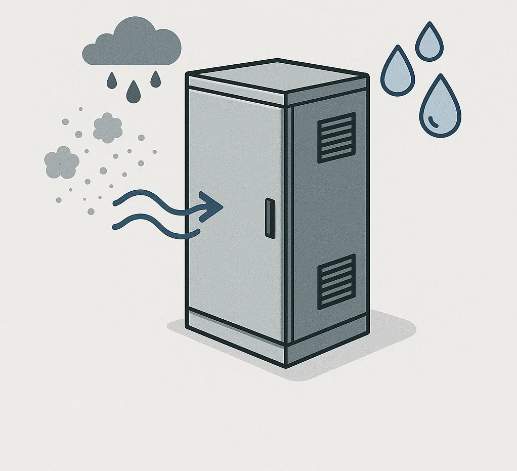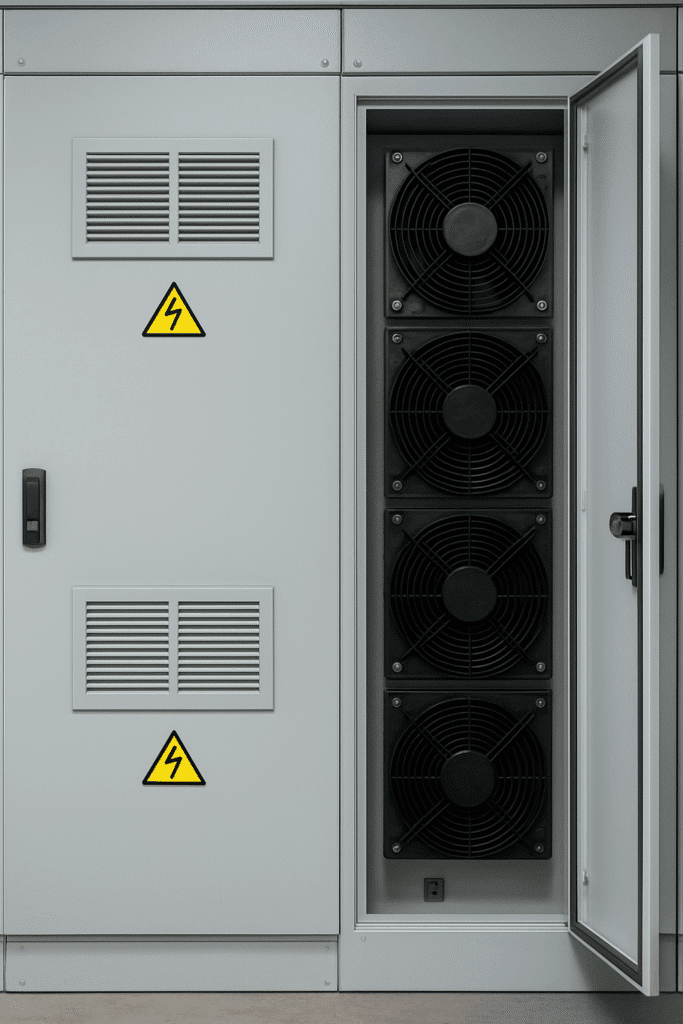Why Is Proper Airflow Evaluation So Critical?
In industrial fan environments—think electrical cabinets, energy storage systems, and EV charging stations—your fan’s airflow rating is the single biggest factor in reliable heat removal and cost control:
- Too Much Airflow?
- Energy bills skyrocket.
- Excessive noise disrupts equipment and personnel.
- Turbulence can create hot spots instead of cooling evenly.
- Too Little Airflow?
- Heat builds up, causing components to overheat.
- Equipment life shortens and warranties void.
- System instability poses safety risks.
Different applications demand very different airflow targets. For example:
- Standard electrical enclosures: roughly 50–100 m³/h per kW of heat load.
- High‑density PCS racks in energy storage: 120–150 m³/h per kW.
- Outdoor charging kiosks (with dust & weather protection): add another 10–20% margin.
How Do You Estimate Required Airflow from Your Heat Load?

What Is “Heat Load” and How Do You Calculate It?
Heat load (Q), measured in watts (W), is the total continuous heat your system generates—transformer losses, rectifier heat, control-board power draw, and so on.
Basic formula:
Q=∑PlossQ = \sum P_{\text{loss}}
Which Variables Drive Your Airflow Calculation?
- Temperature Rise (∆T): Your allowable internal‑to‑ambient temperature difference (typically 10–15 °C).
- Specific Heat of Air (cₚ): Approximately 1.005 kJ/kg·K.
- Air Density (ρ): Roughly 1.2 kg/m³.
Airflow (V) formula:
V=Qρ×cp×ΔTV = \frac{Q}{ρ \times c_p \times ΔT}
Converting units gives you V in m³/h.
Is There a Quick “Rule‑of‑Thumb”?
- General guideline: 80 m³/h per kW of heat load works for many cabinets.
- Precision method: Use the physics‑based formula above and adjust ∆T for your specific environment.
What Real‑World Factors Affect Your Fan’s Delivered Airflow?
Does Installation Geometry Matter?
- Inlet/Outlet Openings: Smaller filters, grilles, or louvers increase resistance and cut airflow.
- Ductwork & Elbows: Each 90° bend can reduce airflow by 5–10%.
How Do Filters and Seals Play a Role?
- Filter Resistance: A new filter has low resistance, but as it loads with dust, resistance—and energy consumption—climbs.
- Seal Integrity: Gaps around the fan create bypass airflow, reducing the cooling directed where you need it.
- Component Placement: Cables or boards placed too close to the fan inlet can create bottlenecks.
Which Online Tools Make Fan Airflow Calculations a Breeze?

Meet the LEIPOLE Airflow Sizing & Fan Selection Tool
- Instant Calculations: Enter your heat load, ∆T target, and environment data—get results in seconds.
- Report Export: Download professional PDF or Excel summaries for project specs.
- Smart Filters & Ratings: Automatically factor in IP and dust ratings.
- Ready to Try?
Access it here:
https://leipole.com.sg/leipole-electrical-cabinet-cooling-fan-selection-tool/
Templates for Your Specific Application
- Electrical Cabinet Cooling
- Energy‑Storage PCS Enclosures
- Outdoor EV Charging Stations
Each template presets ideal ∆T values, mounting guidelines, and filter requirements—so you spend minutes, not hours, on sizing.
Should You Choose Axial Fan or Centrifugal Fans?
Axial Fan
- High Airflow, Low Static Pressure: Ideal for open‑frame installations.
- Compact Design & Lower Cost.
Centrifugal Fan
- Higher Static Pressure, Moderate Airflow: Best for filtered or ducted systems.
- Handles longer duct runs with ease.
Example Models:
| Application | Axial Fan Model | Centrifugal Fan Model |
| Cabinet Cooling | LEIPOLE ‑230V | LEIPOLE‑200V |
| Energy Storage | LEIPOLE ‑24V | LEIPOLE ‑230V |
| EV Charging | LEIPOLE ‑24V | LEIPOLE ‑24V |
What Are the Top Airflow Sizing Pitfalls to Avoid?
- “Bigger Is Better” Myth: Beyond a point, extra airflow doesn’t improve heat removal but blows up your power bill.
- Ignoring System Resistance: Always account for filters, ducts, and elbows in your sizing calculation.
- Overlooking Maintenance: A fan that’s hard to access or service will degrade performance over time.
Who Can Help If You’re Still Unsure?
Free Sizing Guidance from LEIPOLE Experts
- Online Consultations: Get one‑on‑one advice to dial in your ∆T and airflow targets.
- Remote or On‑Site Heat‑Load Assessments: Detailed analysis and custom recommendations.
- Tailored Solutions: From wind farms to EV chargers, LEIPOLE integrates fans, heaters, controllers, and transformers for turn‑key cooling.
Ready to streamline your cooling design?
Try the LEIPOLE Airflow Sizing & Fan Selection Tool now and get instant, accurate results—no spreadsheets required!
🔗 https://leipole.com.sg/leipole-electrical-cabinet-cooling-fan-selection-tool/



